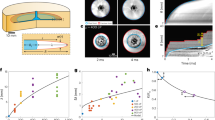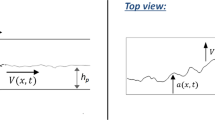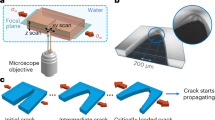Abstract
A rapidly moving crack in a brittle material is often idealized1 as a one-dimensional object with a singular tip, moving through a two-dimensional material. However, in real three-dimensional materials, tensile cracks form a planar surface whose edge is a rapidly moving one-dimensional singular front. The dynamics of these fronts under repetitive interaction2,3,4 with material inhomogeneities (asperities) and the morphology5,6,7,8,9,10,11 of the fracture surface that they create are not yet understood. Here we show that perturbations12 to a crack front in a brittle material result in long-lived and highly localized waves, which we call ‘front waves’. These waves exhibit a unique characteristic shape and propagate along the crack front at approximately13,14,15 the Rayleigh wave speed (the speed of sound along a free surface). Following interaction, counter-propagating front waves retain both their shape and amplitude. They create characteristic traces along the fracture surface, providing cracks with both inertia and a new mode of dissipation. Front waves are intrinsically three-dimensional, and cannot exist in conventional two-dimensional theories of fracture1. Because front waves can transport and distribute asperity-induced energy fluctuations throughout the crack front, they may help to explain how cracks remain a single coherent entity, despite repeated interactions with randomly dispersed asperities.
This is a preview of subscription content, access via your institution
Access options
Subscribe to this journal
Receive 51 print issues and online access
$199.00 per year
only $3.90 per issue
Buy this article
- Purchase on Springer Link
- Instant access to full article PDF
Prices may be subject to local taxes which are calculated during checkout




Similar content being viewed by others
References
Freund, L. B. Dynamic Fracture Mechanics (Cambridge, New York, 1990).
Ben Zion, Y. & Morrissey, J. A simple re-derivation of logarithmic disordering of a dynamic planar crack due to small random heterogeneities. J. Mech. Phys. Solids 43, 1363–1368 (1995).
Perrin, G. & Rice, J. R. Disordering of a dynamic planar crack front in a model elastic medium of randomly variable toughness. J. Mech. Phys. Solids 42, 1047–1064 (1994).
Rice, J. R., Ben Zion, Y. & Kim, K. S. 3-Dimensional perturbation solution for a dynamic planar crack moving unsteadily in a model elastic solid. J. Mech. Phys. Solids 42, 813–843 (1994).
Mandelbrot, B. B. & Pasoja, D. E. Fractal character of fracture surfaces of metals. Nature 308, 721–722 (1984).
Maloy, K. J., Hansen, A., Hinrichsen, E. L. & Roux, S. Experimental measurements of the roughness of brittle cracks. Phys. Rev. Lett. 68, 213–215 (1992).
Daguier, P., Henaux, S., Bouchaud, E. & Creuzet, F. Quantitative analysis of a fracture surface by atomic force microscopy. Phys. Rev. E 53, 5637–5642 (1996).
Daguier, P., Nghiem, B., Bouchaud, E. & Creuzet, F. Pinning and depinning of crack fronts in heterogeneous materials. Phys. Rev. Lett. 78, 1062–1065 (1996).
Bouchaud, J. P., Bouchaud, E., Lapasset, G. & Planes, J. Models of fractal cracks. Phys. Rev. Lett. 71, 2240–2243 (1993).
Kulander, B. R., Barton, C. C. S. & Dean, L. The Application of Fractography to Core and Outcrop Fracture Investigations (The US Department of Energy, Morgantown, 1979).
Bahat, D. Tectono-fractography (Springer, Berlin, 1991).
Sharon, E. & Fineberg, J. Microbranching instability and the dynamic fracture of brittle materials. Phys. Rev. B Cond. Matter 54, 7128–7139 (1996).
Ramanathan, S. & Fisher, D. S. Dynamics and instabilities of planar tensile cracks in heterogeneous media. Phys. Rev. Lett. 79, 877–880 (1997).
Morrissey, J. W. & Rice, J. R. Crack front waves. J. Mech. Phys. Solids 46, 467–487 (1998).
Morrissey, J. W. & Rice, J. R. Perturbative simulations of crack front waves. J. Mech. Phys. Solids 48, 1229–1251 (2000).
Willis, J. R. & Movchan, A. B. Dynamic weight-functions for a moving crack. 1. mode-I loading. J. Mech. Phys. Solids 43, 319–341 (1995).
Sharon, E. & Fineberg, J. Confirming the continuum theory of dynamic brittle fracture for fast cracks. Nature 397, 333–335 (1999).
Wallner, H. Linienstrukturen an Bruchfachen. Z. Physik 114, 368–378 (1939).
Hull, D. & Beardmore, P. Velocity of propagation of cleavage cracks in tungsten. Int. J. Fract. 2, 468–487 (1966).
Willis, J. R. & Movchan, A. B. Three-dimensional dynamic perturbation of a propagating crack. J. Mech. Phys. Solids 45, 591–610 (1997).
Movchan, A. B., Gao, H. & Willis, J. R. On perturbations of plane cracks. Int. J. Solids Struct. 35, 3419–3453 (1998).
Remoissenet, M. Waves Called Solitons (Springer, Berlin, 1996).
Acknowledgements
The authors acknowledge the support of the United States–Israel Binational Fund.
Author information
Authors and Affiliations
Corresponding author
Rights and permissions
About this article
Cite this article
Sharon, E., Cohen, G. & Fineberg, J. Propagating solitary waves along a rapidly moving crack front. Nature 410, 68–71 (2001). https://doi.org/10.1038/35065051
Received:
Accepted:
Issue Date:
DOI: https://doi.org/10.1038/35065051
This article is cited by
-
Propagation of extended fractures by local nucleation and rapid transverse expansion of crack-front distortion
Nature Physics (2024)
-
Crack roughness of high-speed fracture in brittle single crystalline material
International Journal of Fracture (2024)
-
Overcrowding induces fast colloidal solitons in a slowly rotating potential landscape
Nature Communications (2023)
-
Velocity correlated crack front and surface marks in single crystalline silicon
Nature Communications (2018)
-
One cause of pulse-like anomalies observed at Guza before the Wenchuan earthquake
Acta Geophysica (2018)
Comments
By submitting a comment you agree to abide by our Terms and Community Guidelines. If you find something abusive or that does not comply with our terms or guidelines please flag it as inappropriate.



